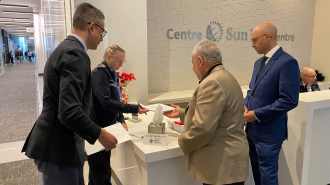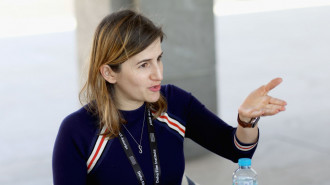
Syria’s cultural heritage could be lost forever

In Aleppo, mounds of gravel dot the landscape where bulldozers and other heavy construction equipment were used to dig the ground for antiquities destined for the black market in Europe and the US.
The scene is a familiar one across the region. More than a decade of conflict has destroyed Syria's rich cultural heritage that stretches back more than 10,000 years.
Ancient sites, archaeological treasures, and famous landmarks have become battlegrounds between combatants or targets for rapacious looters.
"The northwest of the country, home to one-third of the country’s rich cultural heritage, has borne the brunt of some of the most widespread looting and destruction"
February’s earthquake caused further damage to northwest Syria’s already weakened historic buildings, but it is human destruction that has done the bulk of the damage.
Syria was no stranger to looting prior to the uprising in 2011. The country’s archaeological sites and ancient ruins were under the tutelage of the Assad family.
Maher Assad, the younger brother of President Bashar al-Assad, and his uncle Jamil al-Assad were known to “protect” organised groups of looters plundering the ancient city of Palmyra for priceless antiquities years before the Islamic State group (IS) made an appearance and carried out its own destruction.
|
But while looting was largely confined to groups associated with the regime, the civil war and the ensuing chaos incentivised other groups looking for ways to extract revenue from the region.
The northwest of the country, home to one-third of the country’s rich cultural heritage, has borne the brunt of some of the most widespread looting and destruction.
Most of these ancient sites have been caught in the crossfire of the country’s conflict with several World Heritage properties used as military outposts by armed groups and subjected to direct shelling and aerial bombings.
Vandalism illegal excavations and human occupation have compounded the issue.
“Greek gold coins are sold for between $10,000 to $50,000, and some can reach up to $100,000. As for Roman gold coins, the price for one item ranges from $3,500 to $7,000, and some are sold for as much as $17,000"
The situation is further complicated by territorial divisions and weak governance stemming from Syria's civil war. In the northwest, Hayat Tahrir al-Sham (HTS) controls swathes of Idlib and small parts of Aleppo, Latakia and Hama provinces.
Turkish-backed armed groups operating under the umbrella of the Syrian National Army (SNA) hold sway in northern Aleppo, Afrin and the areas between Tal Abyad and Ras al-Ayn. In all of these areas, measures to clamp down on looting are weak to non-existent. Unofficial cover by these armed actors for looters is widely suspected.
|
Looting can be an extremely lucrative business. Coins, jewellery, statues, metalware, metal sculptures and ceramics are among the items commonly found, says one local academic who prefers to remain anonymous.
“Greek gold coins are sold for between $10,000 to $50,000, and some can reach up to $100,000. As for Roman gold coins, the price for one item ranges from $3,500 to $7,000, and some are sold for as much as $17,000."
Many of the items shuttled by middlemen end up for sale in towns near the Turkish-Syrian border, while others disappear into the black market.
Alongside looting by criminal groups, historic landmarks have been caught in the crossfires of military operations. In January 2018 shelling from Turkish forces during Ankara’s nearly two-week offensive against the Syrian militia YPG (People’s Protection Units) damaged the 3000-year-old Ain Dara temple.
Around 60% of the temple was destroyed according to the Syrian Observatory for Human Rights (SOHR).
It's a similar story in Idlib and surrounding HTS-controlled areas, home to some of Syria’s most prominent ruins. Among them are the Forgotten Cities, a group of 700 mostly Byzentine-era settlements between Aleppo and Idlib that were largely abandoned 1000 years ago.
Idlib alone hosts approximately one thousand archaeological sites including 760 registered archaeological sites on the ministerial list and forty archaeological villages listed on the UNESCO World Heritage list.
Various groups engage in targeted excavations across most archaeological areas in northern Syria, sometimes using metal detection devices and heavy digging equipment.
According to one knowledgeable source, HTS allows treasure hunters to operate in exchange for a cut of the profits. No archaeological site in the region has been spared.
In addition, the effects of more than a decade of conflict-related displacement have taken their toll on sites of cultural and/or religious significance.
IDP families have set up homes inside the ruins of churches and other ancient structures such as the historic Christian settlement of Babisqa, a once popular attraction for tourists now full of tents where children clamber over rocks and washing hangs in front of tall arcade columns.
The families are some of the estimated 2.8 million displaced people in northwest Syria, with 1.3 million residing in Idlib alone.
A lack of water and electricity makes life almost unbearable. But the alternative for those unable to afford rent elsewhere is one of the crowded refugee camps near the Turkish border.
"More than a decade of conflict has damaged some of Syria’s archaeological treasures, many beyond repair. Those who are actively engaged in preserving those treasures are not giving up"
While international aid efforts tend to prioritise food, shelter, and education, the focus on preserving archaeological sites remains extremely limited.
More than a decade of conflict has damaged some of Syria’s archaeological treasures, many beyond repair. Those who are actively engaged in preserving those treasures are not giving up.
|
“It is crucial to take protective measures at this time to preserve these sites for future generations,” says Ayman al-Nabo, director of the Idlib Antiquities Centre.
“Not only are they of human importance, but they also represent a significant economic resource for the future, playing a substantial role in tourism, contributing to historic research, and attracting historians and excavation missions from international universities.”
On the ground, groups of archaeologists, activists and historians are working to protect and preserve the region’s heritage. Yet without buy-in from civilian and military authorities controlling the region, they face an impossible task.
“The responsibility for protection must be shared between civil and local authorities and society more broadly,” says Nabo.
Without this, what remains of Syria’s cultural heritage may be lost forever.
Hannah Wallace is a London-based writer and researcher on armed violence and foreign affairs









 Follow the Middle East's top stories in English at The New Arab on Google News
Follow the Middle East's top stories in English at The New Arab on Google News


